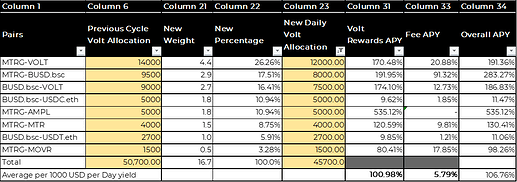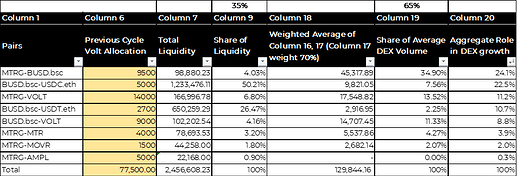Hello Meterians,
The fourth Incentive cycle on Meter Mainnet started on Feb 6, 2022, and ended on Mar 7, 2022.
As the fourth cycle comes to an end, we will review the performance of the incentivized pairs and determine the reallocation of volt for the fifth cycle from Mar 7, 2022 to Apr 6, 2022.
We have a different ongoing forum discussion to adopt a new approach for Volt allocation to liquidity pools here;
We will focus on the new approach with the next cycles.
Few Important aspects to be outlined;
- Due to the exploit of Meter Passport, the WETH and BNB assets are unbacked on Meter Mainnet and Theta Mainnet. The existing pools will be discontinued to ensure all existing liquidity is removed and the assets are out of circulation
- To ensure that the users continue to earn rewards on their capital, we propose a daily allocation to the VOLT single staking pools until the pools can be restarted
- Meter Mainnet VOLT single staking pool allocation – 2000 Volt daily
- Theta Mainnet VOLT single staking pool allocation – 500 Volt daily
TL, DR:
Evaluation of Incentivized Liquidity Pairs:
We could define a few of the critical parameters that will help us evaluate the performance of the liquidity pairs on Voltswap;
- Transaction Volume
a. This is by far the most important parameter for evaluation since the goal of the product is to generate free cash flows from the operations and be self-sustainable
b. Transaction volume is also largely dependent on market conditions and token specific events, to smoothen the effect of these variations, we have considered both Median as well as Average volume - Total Value Locked (TVL)
a. This is a critical parameter to gauge the adoption of the DEX. Higher TVL is typically correlated with higher adoption and enables bigger buys on the DEX without too high a price impact - Turnover of the pair
a. It can be defined as the ratio of Volume by TVL
b. Higher volume for a specific TVL means that the pair has a higher utilization of assets and the LPs are generating higher revenues due to the turnover.
Evaluation Parameters;
- The overall role of a pair is a factor of both the TVL it adds to the Voltswap as well as the transaction volume of the pair.
- However, the intent of TVL is to primarily aid transactions and lower slippages, we will try to weigh transaction volume at 65% and TVL at 35% to gauge an overall role of a pair in the growth of the ecosystem
- We will also try to look at the turnover (average Volume by TVL) to determine the capital efficiency of the pairs
Based on the above parameter, lets us look at the statistics on Meter Mainnet
- Current Volt allocation to the Incentivized Pairs
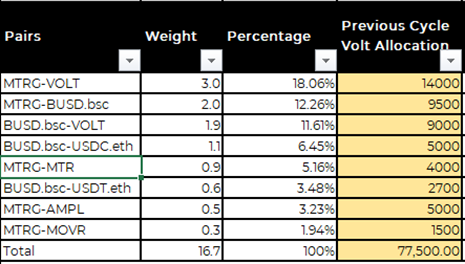
- Daily transaction volume of Incentivized Pairs
- Liquidity for Incentivized Pairs
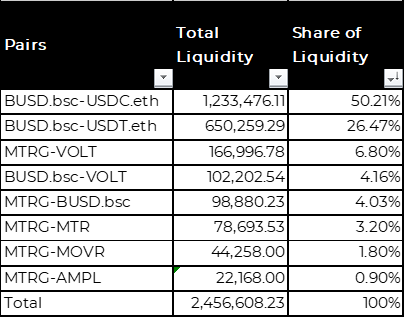
- Transaction Volumes for Incentivized Pairs – Since transaction volumes do depend on market conditions and token specific events, a smoothening effect is applied to add higher weights to immediate past
Column 10,11,12 are average volumes
Column 13,14,15 are median volumes
Column 18 is the overall average volume of each pair smoothened for periods (7-day, 30-day, Total Vol) and method (average volume and median volume). Pure Average volume would have the bias of outlier days where there is very high transaction volume or very low transaction volume
- Evaluation of Pairs based on overall role in DEX Growth (65% weight to transaction volume and 35% weight to TVL)
- Turnover (Volume by TVL) for Incentivized Pairs
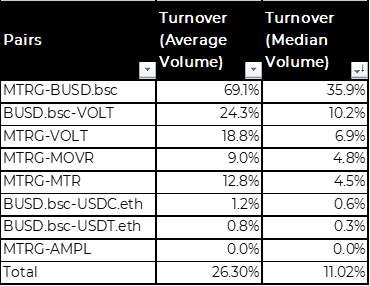
- Volt Earnings per 1000 USD of Liquidity provided
Based on the above insights, the volt allocation proposed for the fifth cycle on Meter Mainnet are as below;
The Volt Earnings per 1000 USD of Liquidity provided based on new Volt allocation is as below;
